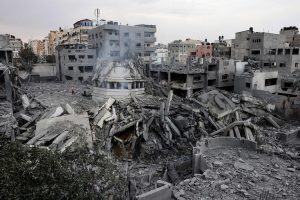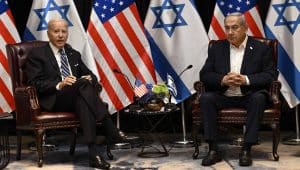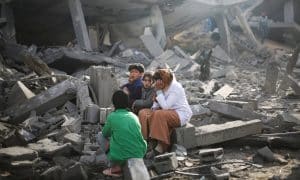The eyes of the world have been on the Middle East since the imperialist attack that killed Iranian General Qasem Soleimani on Jan. 3. On Jan. 11, the Iranian regime officially admitted that it had shot down a Ukrainian commercial airliner “by human error,” causing the death of 176 people, among them 82 Iranians and 63 Canadian nationals (Canada is the destination of many Iranian emigrants), as well as Ukrainians, Swedes, Afghans, Germans and Brits. This took place in the midst of a delicate geopolitical and military situation as the Iranian regime faces an internal crisis and major anti-government mobilizations. In this article we will address the main contours of this complex situation.
Soleimani’s Assassination and the Iranian Response
Soleimani’s assassination opened up the possibility of a military escalation with unpredictable consequences. If Trump’s action was mostly an adventure with little strategy, the Iranian military response of attacking the U.S. bases of Ayn Al Asad and Erbil in Iraq was a calculated move to prevent escalation into open warfare. Iran’s main response was not this, however, but its decision to abandon the nuclear energy agreements signed in 2015 with the Obama administration, agreements that Trump abandoned in 2018 (while imposing a whole series of economic sanctions on Iran). Iran had up to this point maintained the agreement with the other signatory powers: the United Kingdom, France, Germany, Russia and China. This latest response from Iran was a way of saying, “We do not give up” despite the assassination and the sanctions.
In his press conference on January 8, Trump presented the Iranian bombings and the absence of casualties as a victory, and he declined to escalate militarily, proposing instead the deepening of imperialist sanctions and calling on the other imperial powers to abandon the nuclear agreement. The Pentagon had previously circulated a letter—“by mistake,” according to the official explanation—announcing that the United States would withdraw from Iraq. This could be interpreted as a “message” to Trump that the U.S. military would resist the troop surge in the Middle East. Previously, the Iraqi parliament had voted to denounce the U.S. presence in the country as a violation of its sovereignty and to demand the U.S. withdrawal. The parliamentary session, which was held at the request of Interim Prime Minister Adel Abdul Mahdi, was attended by 168 legislators (only three more than the quorum), all of them Shiites1Sunni and Shiite are the two main branches of Islam. The division dates back to 632 A.D., after the death of the prophet Muhammad. For the Sunnis, the successor was to emerge from the community of believers, while the Shiites believed that he should follow the line of succession in the family of the Prophet. Shiism, which literally means “Ali’s party” (Ali was Muhammad’s son-in-law), established its own dynasties in what is now Iran. Although they are a minority of 15 to 20 percent throughout the Islamic world, the Shiites are in the majority in Iran and Iraq, and represent a significant minority in Lebanon, Yemen and Kuwait. Sunnis, on the other hand, who are the majority among Muslims, represent more than 80% of the population in Saudi Arabia, the United Arab Emirates, Jordan and Egypt; and more than 60% of the population in Syria, Qatar and the West Bank, with significant minorities in Yemen and Oman., while Sunni and Kurdish parliamentarians boycotted it.2While the resolutions, unlike the laws, are not binding, the Sunni Arab and Kurdish minorities fear that the expulsion of the U.S.-led coalition will end up empowering the Iranian-backed Iraqi Shiite militias.
The fact is, the escalation that could have happened didn’t. A thin line separated one scenario from the other, as the Ukrainian commercial airliner blast shows. But the causes behind Soleimani’s assassination and the military crisis, both the uncertain ones and the apparent ones, have only deepened.
The Middle East and the Decline of U.S. Imperialism
The ancient Greek historian Diodorus Siculus, a contemporary of Julius Caesar, wrote in relation to the Roman Empire that “those who wish to achieve hegemony acquire it with courage and intelligence, increase it with moderation and benevolence and maintain it with fear and paralyzing terror [phobos kai kataplêxis].” The latter, according to Perry Anderson in his book “The H-Word,” could describe the type of hegemony deployed by the U.S. during the so-called war on terror. Thus, after the attacks on the Twin Towers on September 11, 2001, George W. Bush launched the invasion of Afghanistan and the second war in Iraq (2003). In this way, U.S. imperialism set out to manage the relative decline of its hegemony through terror.
With the invasion of Iraq it had the arrogant objective of destroying a state and creating another one according to its interests (what was called nation-building). The first part of the equation was achieved (with a human cost that, according to conservative estimates, amounted to 600,000 deaths); the second part was not. The unintended consequence was the strengthening of Iran, which has been one of Iraq’s main regional rivals since the 1979 Islamic Revolution. This revolution ended up being led by the theocratic Ayatollah Khomeini but had a much more radical origin, which led among other things to the development of the Shoras, proto-workers’ and soldiers’ councils, and whose radical sectors—including the Kurdish movement—had to be defeated in order to impose the theocratic state.
Trump’s Shift
In the 2015 agreement with the United States and other powers, Iran committed to freeze its nuclear program in exchange for avoiding economic sanctions. This was part of a strategy of “containment” toward Iran within the framework of the chaos generated by the very imperialist policy of oppression, military intervention and promotion of inter-religious struggle. Trump’s abandonment of these agreements in 2018 and the application of new and harsh economic sanctions was part of a turnaround in the policy of U.S. imperialism and of the return of the great powers’ nationalism, which increasingly colors the current international scenario and that has replaced the previous imperialist “globalism.” The Iranian sanctions, to which new ones were added Jan. 10, are at the base of the country’s economic crisis.
Trump’s strategy of “extreme pressure” has led to a series of events, most of which have been unofficially attributed to Iran or its allies, and which ended up escalating tensions last week. From May to June, oil tankers were attacked in the Iranian-controlled Strait of Hormuz; in June a U.S. drone was shot down over Iranian airspace (which the U.S. denies); in September a drone attack took place, endangering the capacity of Saudi Arabia’s refineries and attributed to Iran’s allies in Yemen; while in December an attack attributed to the pro-Iranian Iraqi organization Kataeb Hezbollah ended with the death of a U.S. mercenary. The U.S. responded to this last event with a bombing that left at least 25 dead from this Iraqi militia, which provoked a wave of repudiation among the different militias that respond to Iran inside Iraq and ended in the assault and seizure of the U.S. Embassy in Baghdad, in the “green zone” (supposedly the safest place in the country). This forced the United States to evacuate all its officials; three days later Soleimani, the Iranian regime’s second in command after Ayatollah Ali Khamenei, was assassinated.
Ultimately, the key issue is Iran’s subordination in the context of imperialist control over the Middle East. Far from being resolved in the present crisis, this has become more acute. In the heat of American hegemonic decline, and the failures of its interventions in the region, Iran overextended itself militarily and politically—through a series of proxy organizations—in Iraq, Yemen, Syria and Lebanon. This territory gave it a corridor to the Mediterranean, emulating the boundaries of the old Persian Empire. This, together with the permanent threat of advancing in its nuclear plan, is what allows it to counterbalance the hostility of the United States’ direct agents in the region, Israel and Saudi Arabia.
Yet because of the Middle East’s geopolitical position and hydrocarbon resources, which continue to be the world’s main source of energy, the region has a strategic character that U.S. imperialism cannot afford to abandon without also weakening itself in the face of rival powers. Despite Trump’s speech, in which he said he can withdraw from the Middle East because he does not depend on its oil (the U.S. currently produces more than it consumes), this is untrue as shown by the abrupt drops in the stock markets or the increases in oil prices every time there is a crisis in the region.
Russia and China, meanwhile, perfectly understand this ABC of geopolitics. Contrary to the alleged Trumpist isolationism, these countries are increasingly extending their tentacles into the Middle East. It is not only a matter of infrastructure, common oil projects or trade, which effectively exist, but of establishing a toehold in the region and occupying all the spaces left vacant by the United States. The most palpable image of this was Russian President Vladimir Putin’s surprise visit to Syria in the midst of the tensions between the United States and Iran, sending a clear message to both countries that he was not going to allow a war to ruin the power that the Kremlin has conquered in Syria in recent years, making agreements with practically all the regional actors.
Iraq in the Crossfire
Iraq is where the U.S.-Iran confrontation has played out. Contrary to what one might think, both countries worked together after the overthrow of Saddam Hussein and the military occupation to shape what would become the new Iraqi regime. The imperialist “new democracy” sought to balance the different ethnic and religious components with power quotas for each, giving it zones of control and effectively dismembering the country between a northwest and center with a Sunni majority, a center and south controlled by the Shiites, and a northeast controlled by the Kurds. In this process of “normalization,” Iran was a key factor, given the Shiite majority of the population and the political-ideological weight of its main clergymen. Iran’s importance finally became determinant, as its influence grew beyond the religious and political sphere into the military arena, establishing militias integrated into the Iraqi state that respond to Iranian interests.
The journalist Patrick Cockburn points out that the real history of U.S.-Iranian relations has been a strange mixture of rivalry and cooperation: “This is not obvious because the cooperation was largely covert and the rivalry explicit.” He continues: “Both countries wanted a stable Shiite government in power in Baghdad and realized that this could only happen if the U.S. and Iran agreed on who the acceptable Iraqi leaders would be.” So since the 2005 U.S.-drafted constitution defining a Kurdish president, a Shiite prime minister (who actually holds the power) and a Sunni speaker of parliament, the U.S. and Iran have chosen the prime minister by consensus over the years.
But before the military escalation between the United States and Iran, Iraq was becoming a social powder keg. The last elected prime minister, Adel Abdul Mahdi, had to resign in November amid the most massive street protests in recent history. He stayed on only as interim prime minister, because there was no way to find a consensus successor.
The Cycle of Revolts and the Crisis of the Iranian Theocracy
The overextension of Iran’s regional influence is highly contradictory given the crisis facing the theocracy, that is, the deep economic and social crisis—largely a product of the harsh policy of U.S. sanctions—and the important revolts it faces in its area of influence and, above all, in Iran itself.
The imperialist sanctions have been hitting the Iranian economy hard. Its oil exports plummeted from 2.4 million barrels a day in April 2018 to less than 500,000 in September 2019. During this period, inflation soared, the Iranian currency was devalued by 60% and the economy went into recession. Only partially did the non-oil sector manage to cushion the blow (57% of Iran’s exports are not oil). According to IMF estimates the contraction of GDP in 2019 amounts to more than 9%. On November 15 the High Economic Coordination Council of Iran announced fuel rationing and price increases of up to 300%. While much of the economy (and its profits) is concentrated in the hands of the theocracy and religious foundations, President Rouhani argued that ending fuel subsidies was necessary to “move” them to the poor. That price increase was a catalyst for the revolt.
Protests began the same day. Initially they were against the increase in fuel prices and demonstrations erupted in the capital, Tehran, but these protests quickly spread to more than 21 cities in the country and began to question the government and the regime. Although there are no official data and the government restricted internet access to prevent the demonstrations from spreading, various sources put the number of deaths during the protests at 300 or more, though we cannot know for sure. In any case, the brutal repression deepened the revolt. Some 700 government banks were destroyed, including Iran’s central bank, Islamic religious centers, and both statues of Ayatollah Ali Khamenei and anti-American posters were torn down. This series of protests has been described as the most violent since the 1979 revolution.
But the cycle of revolt is not limited to Iran but has spread to its area of influence. In Lebanon, mass mobilizations forced the resignation of Prime Minister Saad Hariri. And in Iraq protesters are fed up with the country’s social, economic, political and military conditions. After years of occupation and war, which resulted in hundreds of thousands of deaths and as many refugees, today 60% of the Iraqi population is under 25 years old and 40% of these young people are unemployed. Most of them have lived their entire lives under occupation and war, and the image they have of politicians is of a corrupt caste who negotiated the country’s natural and economic resources with the imperialist powers, leaving Iraq destitute. That is why the recent protests, which were led by a majority of Shiite youth, focused on questioning the political regime, the presence of U.S. military troops and the growing political-military weight of Iran in the country.
Trump’s attack and Soleimani’s massively attended public funeral created an opportunity for the regime to deflect from this cycle of protests. However, on January 10, there were already new mobilizations in Iraq, and the downing of the Ukrainian commercial airliner, with the vast majority of its Iranian passengers, which the Rouhani government denied for days and now recognizes as the product of “human error”, threatens to be the catalyst for a new chapter of the deep internal crisis that Iran is going through.
American Decline and the Power Play
Ultimately, the “legacy” of the failed U.S. plan to build a new Iraqi state according to its interests, ended up under the trumpet of the current chimera of an ungovernable country that may no longer be the only terrain in dispute with Iran, which raises the possibility of progress by other powers. On January 10, the Russian agency RIA Novosti informed that after the American attacks, talks had been resumed for Iraq to acquire the Russian S-300 surface-to-air missile defense systems. This is in addition to the agreements that Putin had recently negotiated with the Turkish president, Recep Erdogan, in his whirlwind trip, which include the purchase by Turkey of the S-400 Triumf long-range air defense missile systems that would replace the US Patriot system. In other words, this is a nightmare scenario for US imperialism, which is sharpened by Trump’s policy and leads to the advance of other powers. In the framework of the global geopolitical dispute with China, this dispute goes far beyond “trade”.
The battered American hegemony seems to be receding even beyond that phobos kai kataplêxis or paralyzing fear and terror of which Sículo spoke and with which the United States has faced during its decline since the beginning of the 21st century. This, however, does not make it a more moderate imperialist power but more unstable and aggressive. The military crisis that developed was a sign of this. It cannot be separated from the overall picture marked by the historical crisis of current capitalism – a creeping economic crisis and the impossibility of capitalism to find new engines of the world economy, the return of the nationalism of the great powers, the proliferation and deepening of “organic crises”, or elements of them, in multiple countries (both imperialist and peripheral), and the eruption of a new cycle of class struggle at the international level, all of which together make up a new international scenario.
This article was originally published in Spanish on our sister site La Izquierda Diario.
Notes
| ↑1 | Sunni and Shiite are the two main branches of Islam. The division dates back to 632 A.D., after the death of the prophet Muhammad. For the Sunnis, the successor was to emerge from the community of believers, while the Shiites believed that he should follow the line of succession in the family of the Prophet. Shiism, which literally means “Ali’s party” (Ali was Muhammad’s son-in-law), established its own dynasties in what is now Iran. Although they are a minority of 15 to 20 percent throughout the Islamic world, the Shiites are in the majority in Iran and Iraq, and represent a significant minority in Lebanon, Yemen and Kuwait. Sunnis, on the other hand, who are the majority among Muslims, represent more than 80% of the population in Saudi Arabia, the United Arab Emirates, Jordan and Egypt; and more than 60% of the population in Syria, Qatar and the West Bank, with significant minorities in Yemen and Oman. |
|---|---|
| ↑2 | While the resolutions, unlike the laws, are not binding, the Sunni Arab and Kurdish minorities fear that the expulsion of the U.S.-led coalition will end up empowering the Iranian-backed Iraqi Shiite militias. |












